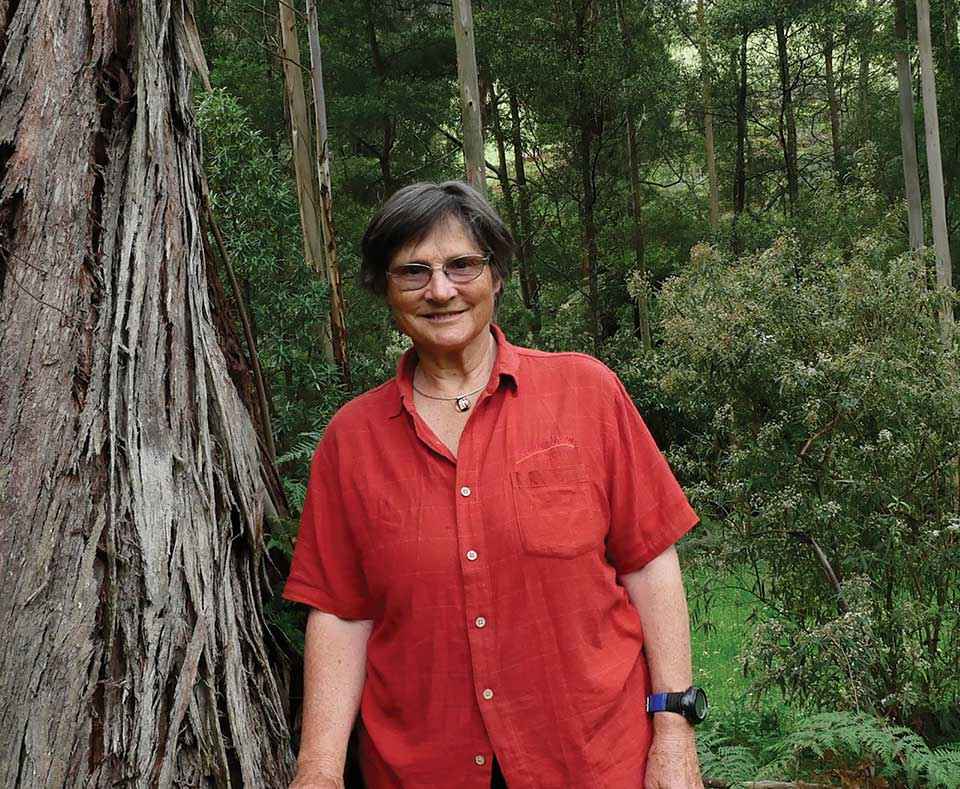Victorian Landcare Magazine - Summer 2019, Issue 74

“If you get lost just walk down a creek and you’ll reach a road to home.” This was my father’s advice to me as a child when I set out exploring in Sherbrooke Forest in the Dandenong Ranges. From these early wanderings came my love of the environment and my venture into Landcare.
In 1987 my partner David Neilson and I moved back to the Dandenongs to 10 hectares that had been part of a farm my grandfather had cleared, leaving just 10 large mountain ash. We were now the proud owners of land and keen to revegetate. The cattle were removed,
and we watched to see what would happen. Not surprisingly the blackberries took off and the dry grass became a fire risk.
A group, a network, a coalition…
With some local friends we formed Johns Hill Landcare Group (JHLG) in 2002 aiming to reconnect the bush between Belgrave and Gembrook. Our agenda was fitted around available grants – planting on unused roads and creek lines, weed control and revegetation on private properties.
I also helped set up the Cardinia Environment Coalition (CEC) – an association of local Landcare and friends groups in order to provide input to the new Cardinia Shire Council. We also worked with the Shire of Yarra Ranges and went on to form the Southern Ranges Environment Alliance that covered our area.
Two questions kept bugging me. First, how can the knowledge of local experts be passed on? A couple of the members of JHLG were top seed collectors for native nurseries but were approaching 80 so while their brains were good, their legs were less so. And second, why don’t people do their weeds? We didn’t know what motivates people to tackle weed control. A lot of effort was going into awareness programs, but we didn’t know if they worked. In 2009 JHLG partnered with Cardinia Shire Council to research the incentives and barriers to weed control.
Two questions kept bugging me. First, how can the knowledge of local experts be passed on? And second, why don’t people do their weeds?
Weed research produces successful model
We targeted people who wanted to do their weeds but didn’t. The barriers were time, cost, inappropriate information and inaction by neighbours. The motivators were financial support and a Landcare person who provided appropriate information. The time barrier was overcome by doing a weed plan and the bad neighbour problem by working at a local level.
A successful pilot followed with funding for a neighbourhood weed facilitator and weed contractors. Now, 25 landowners are still doing their weeds. The model works but funding is hard to find for someone to build relationships with individual landholders.
In 2010 Landcarers in central Victoria asked for my advice on how they might work at a landscape scale. After a lot of hard work by many people the Central Victorian Biolinks Alliance was formed. The alliance has 18 Landcare network members, and funding for four projects that will bring local knowledge and the best science together to protect species and prepare for climate change.
Landcare is a brilliant model. It is all about building relationships – on committees, with landholders and with agencies – to deliver healthy
natural systems and sustainable farming. But relationship building is under-valued and there is little funding. The stop-start grant model is inefficient as we lurch forward with good work, then backwards as funding dries up. It is dispiriting for volunteers.
We have put 20 years of work into our own property. Thanks to Melbourne Water’s Stream Frontage Management Program, seven of our 10 hectares are now under a Trust for Nature covenant. Once the blackberries were removed and after extensive weeding and planting the natural regeneration has returned with vigour. The 10 mountain ash are tall and healthy. I wonder what my grandfather would think…
Karen Alexander is a life member of JHLG and Bush Heritage Australia and a board member of Central Victorian Biolinks Alliance. She was awarded an OAM for services to the environment in 2015 and was the 2014 Emerald Citizen of the Year.
For information on the Central Victorian Biolinks Alliance go to https://centralvicbiolinks.org.au
For more information on Johns Hill Landcare Group's weed research go to www.johnshill.org.au/weeds-away/